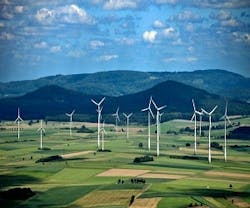Fluctuating Wind Power and Efficiency
Has your facility considered taking the renewable jump? Sustainable energy methods are becoming more pervasive each year, with technical innovations making options more affordable. Incorporating wind power into existing power grids is challenging because fluctuating wind speed and direction means turbines generate power inconsistently. Coupled with customers' varying power demand, many wind-farm managers end up wasting power-generation capacity and limiting the service life of turbines through active control – including fully stopping turbines – in order to avoid any possible damage to the power grid from spikes in supply.
In a paper published in the American Institute of Physics' Journal of Renewable and Sustainable Energy, researchers propose a new strategy to optimize power-generation efficiency and so better control wind farms.
The new strategy is based on continuous predictions of how fluctuating winds affect each turbine's maximum generation capacity. It also incorporates factors missing in other wind-farm control strategies, including differing power generation between turbines, actual fluctuations in power generation capacity, errors in prediction, communication disruptions preventing active control, and even turbines without the capacity for continuous active control. To demonstrate the feasibility of the new strategy, the researchers compared their predictions to raw data from a single wind turbine. The team then further refined their calculations and simulated a control operation with data from a wind farm of 33 turbines.
The results suggest that wind-farm managers can improve their power-generation efficiency with the new strategy. However, the researchers caution that before implementing the strategy, each wind-farm manager should adjust the underlying parameters – such as how often to adjust each turbine's speed – based on local conditions.
